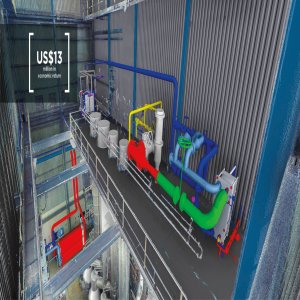Efficient Pipeline System Has Vital Role in Energy Transition

STORY INLINE POST
Q: What are CENAGAS’ noteworthy achievements of 2018?
A: CENAGAS is mandated to provide an efficient natural gas transport service through SISTRANGAS. This mandate will contribute to the clean power generation market’s participation in the country’s energy mix and will play a pivotal role in Mexico’s energy transition. A recent landmark is the renewal of CENAGAS’ firm base contracts. We concluded the first open season in 2017 and placed 97 percent of SISTRANGAS’ firm base capacity via one-year term contracts. We launched the contract renewal process early on and we are pleased to say the number of contracts has increased considerably, meaning that service unbundling is progressing at a fast pace across the country. To date, we have more than 60 firm base contracts. This progression shows traders and final consumers are choosing to directly administer their capacity. Another critical milestone is the increase in SISTRANGAS’ flexibility and capacity via investments, either from CENAGAS or interconnected private companies. Among the pipelines in the works, Tuxpan is the most advanced. This pipeline represents a sizable injection of millions of cubic feet, unlocking significant supply for the southern and southeastern regions of the country.
CENAGAS also reconfigured the Zempoala compression station via a contract allocated in September 2018. It will compress natural gas and direct it toward the south of Mexico and bolster the system’s flexibility with the addition of two new turbo-compressors that will increase our operational range from 0.35Bcf/d to 1.3Bcf/d as opposed to the previous configuration that only allowed 0.8Bcf/d and upward. The reconfiguration is paired with a general modernization of the compression station’s auxiliary services to bolster reliability in natural gas supply.
Q: How is CENAGAS capitalizing on the USMCA’s energy chapter?
A: The most important aspect of the new agreement is that it remained trilateral. Mexico imports more than 4.5Bcf/d from the US and is getting closer to importing 5Bcf/d. The agreement guarantees no restrictions will be imposed on these imports and natural gas flows between both countries will be free from any additional bureaucratic processes. It is imperative that Mexico continue to receive inflows of the world’s most cost-effective natural gas just as Mexico’s imports are critical for US natural gas producers.
Q: How is CENAGAS preparing for the new administration’s plans to revamp refining and natural gas production?
A: The natural gas transportation system CENAGAS inherited from PEMEX is designed to receive the natural gas produced locally and showcases surplus capacities to pick up natural gas production levels similar to past peaks. We are undertaking an in-depth review of our pipeline network and compressor inventory to make sure our assets continue operating at optimal efficiency levels and in a safe and reliable way. This revision includes both the active assets working daily and those that are not operating because of scarce natural gas flows at national injection points.
Q: How will CENAGAS’ MX$1.75 billion investment announced for the Yucatan Peninsula be allocated?
A: Part of this investment will be allocated to the reconfiguration of the Zempoala compression station and the interconnection of the Tuxpan pipeline. Another project to be financed by this investment is ENGIE’s interconnection between the Mayacan system with SISTRANGAS pipelines in the southeastern region of the country to freely transit toward the Yucatan Peninsula. ENGIE is additionally investing in the Mayacan pipeline to increase compression capacity and possible flow. Its capacity is close to 0.25Bcf/d while flows have yet to surpass the 0.08Bcf/d mark.
Q: What is the logic behind increasing SISTRANGAS’ tariff zones from six to nine?
A: The new SISTRANGAS tariffs were enacted on Oct. 1, 2017, including a rezoning. The increase in the number of zones from six to nine stemmed from the need to split the size of the Gulf tariff zone, which was quite large, into three separate zones. The end goal was to design a more efficient tariff system, with fewer crossed subsidies. The previous zone delimitation was based on such a large zone because the price was regulated under PEMEX’s first-hand sale scheme. That ended in July 2017, making the rezoning necessary. With the end of this scheme, it made more sense to reduce the Gulf zone and divide it into a sufficient number of sub-zones to obtain natural gas prices that reflected the reality of the logistics necessities of each zone. It is not designed to increase CENAGAS’ income. Rather, the primary goal is to make CENEGAS more efficient and competitive given we are facing competition from pipelines being developed outside of SISTRANGAS that can deliver fuel to the same locations in which we operate.
Q: How is CENAGAS’ Consulting Committee contributing to the company’s objectives in the natural gas market?
A: CENAGAS has two fundamental roles in terms of business lines. First, as natural gas distributor with 8,900km of pipelines and nine compression stations at the core of the country’s natural gas system. CENEGAS has a great responsibility to ensure those pipelines are operating seamlessly and efficiently, with top-tier O&M services. Second, from its capacity as a technical manager, more in line with public policy objectives, it provides services to the benefit of Mexico’s natural gas supply security. We do so by fostering firm base capacity markets. In this sense, it is imperative for this second aspect to rely on a forum where different market participants and renowned academics can provide feedback on CENAGAS’ actions and programs to advance public policy objectives.
Q: What progress have you seen regarding the coordination agreement between CENAGAS and CENACE?
A: CENAGAS and CENACE were created on the same day and both operate as control centers, the former for natural gas and the latter for electricity. While there are differences between both, we also have similarities. Our core objective as control centers is to offer the safest, most reliable and efficient transport system aligned perfectly with CENACE’s mission to offer an electricity system that is equally safe, reliable and efficient. In this sense, part of our work requires us to provide feedback related to project demand growth projections for electricity and natural gas, coupled with ensuring the safety and reliability of natural gas supply to enable a solid electricity industry. When operating with a vision of natural gas as a transition fuel, it is particularly critical to enable the support it can provide to tackle renewable energy intermittency. This is why constant coordination between CENAGAS and CENACE is equally critical. The first fruits of this collaboration have resulted in planning improvements, emergency reaction and management between both control centers as well as administrative efficiencies.
Q: What was the most insightful feedback from CENAGAS’ second public consultation?
A: These public consultations allow CENAGAS to have direct contact with final users, traders and local and state authorities that make use of our infrastructure. It is where our demand is. It is a central exercise as it constitutes a perfect complement for our top-to-bottom planning with a bottom-to-top perspective. This second public consultation was an improvement compared to the first one because we created online formats through which people could interact with us directly. On this occasion, instead of a single event in Mexico City, we organized several in other parts of the country, including Chihuahua, Monterrey and Merida. The common denominator resulting from our interactions was an increased demand for backhaul services. It also brought clarity regarding the regions that expect the greatest growth in natural gas demand, what types of services they are expecting and what storage services and ancillary services will complement them.
Q: What technologies is CENAGAS looking to implement to improve its natural gas distribution service?
A: While natural gas distribution has not changed much in the last 60 years, data-related technologies have dramatically evolved, as well as metering system technologies. These new developments enable us to generate sizable volumes of additional information and to obtain it in short periods of time. CENAGAS is close to concluding the deployment of its own SCADA system. This enables CENAGAS to use its own main and alternate control rooms that monitor a generalized SCADA operation of SISTRANGAS’ pipelines. We are also fairly advanced in a telecom project that will provide CENAGAS with independent communications instead of those historically used by PEMEX. The next step will be to invest in the modernization of all the metering and on-site transmission systems to gradually replace mechanical meters with computers on a national scale to effectively measure and monitor the volume, pressure, flow and natural gas quality conditions. This data will be transmitted to a control center that unlocks the possibility of real-time decision-making related to the operation of SISTRANGAS.
Technological developments have also drastically improved internal pipeline inspection. CENAGAS is investing heavily to assemble an interior inspection plan for its pipelines to identify potential flaws and repair them preventively. We are also pairing corrective maintenance with Big Data practices, applied to both pipelines and compression stations. In essence, we are looking to increase the allowed operational pressure thresholds in our pipelines to offer more supply without sacrificing safety and reliability while decreasing average supply costs.
























